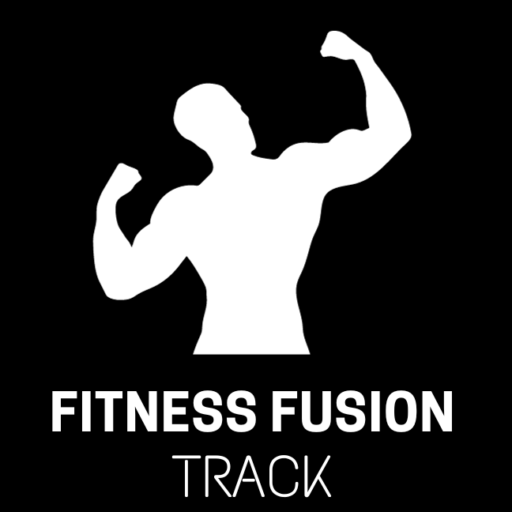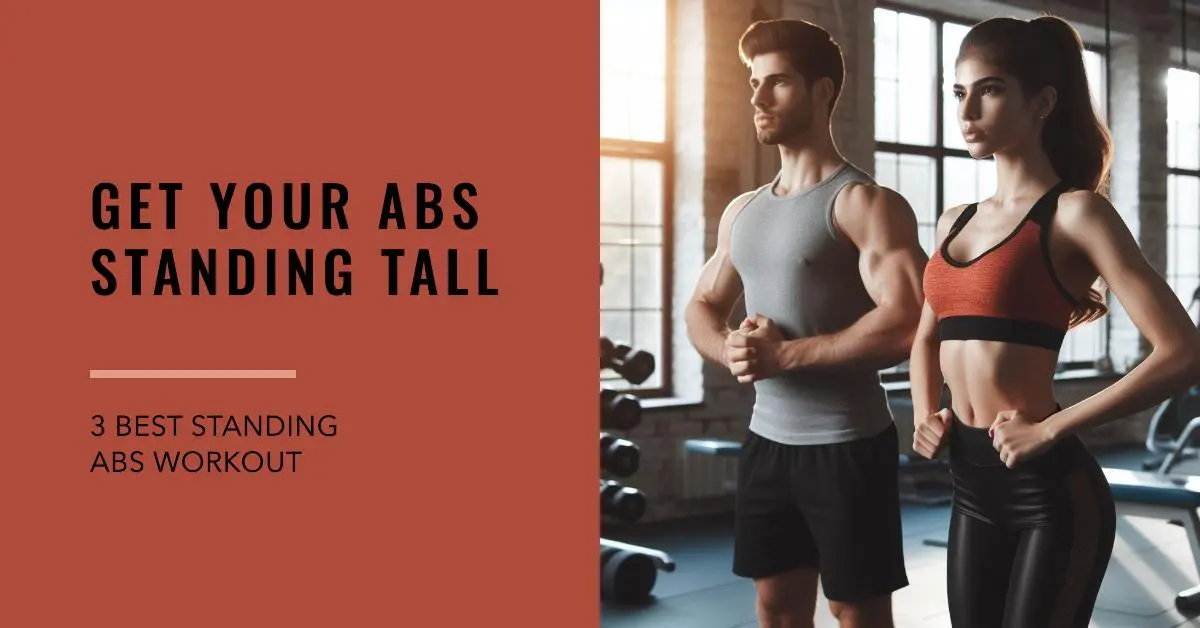When it comes to sculpting a strong and toned core, standing abs workouts offer a convenient and effective solution. By targeting your abdominal muscles while remaining upright, these exercises not only enhance core strength but also improve balance and stability. In this article, we’ll delve into three of the best standing abs workout that will help you achieve a rock-solid midsection. Like standing side crunches, these dynamic movements engage multiple muscle groups, delivering results without the need for cumbersome equipment or uncomfortable floor exercises. Get ready to elevate your core workout routine with these powerhouse exercises.
Benefits of Standing Abs Workout
Engaging in standing abs workouts offers a multitude of benefits for individuals seeking to enhance their fitness level and overall well-being.
- Improved Balance and Stability: Engaging core muscles in a weight-bearing position enhances balance and stability, aiding in better coordination during daily activities and sports.
- Strengthened Core Muscles: Standing abs workouts target not only the abdominal muscles but also the lower back and obliques, leading to improved core strength and stability.
- Better Posture: Strengthening the core muscles through standing abs workouts helps maintain proper spinal alignment, reducing the risk of poor posture-related issues.
- Enhanced Fat Loss: Dynamic movements involved in standing abs workouts can elevate heart rate and boost calorie burn, contributing to fat loss and a leaner physique.
- Accessibility and Convenience: Standing abs workouts require minimal equipment and space, making them accessible to individuals of all fitness levels and facilitating consistency in exercise routines.
Proper Form and Technique
Ensuring proper form and technique is essential when performing standing abs workouts to maximize effectiveness and prevent injury. Here’s a breakdown of the key elements:
- Core Engagement: Begin by engaging your core muscles throughout the entire exercise. This involves contracting your abdominal muscles as if preparing to receive a punch in the stomach.
- Neutral Spine: Maintain a neutral spine throughout the exercise, avoiding excessive arching or rounding of the back. Imagine a line that runs straight from your head to the base of your tailbone.
- Shoulder Position: Keep your shoulders relaxed and away from your ears. Avoid shrugging or tensing the shoulders, as this can lead to unnecessary tension and strain.
- Hip Alignment: Align your hips with your shoulders and feet. Avoid tilting the pelvis forward or backward, which can compromise spinal alignment and stability.
- Steady Breathing: Remember to breathe steadily throughout the exercise, inhaling deeply through your nose and exhaling fully through your mouth. Avoid holding your breath, as this can increase tension and limit performance.
- Controlled Movements: Perform each movement with control and precision, focusing on quality over quantity. Avoid swinging or jerking motions, which can reduce effectiveness and increase the risk of injury.
- Range of Motion: Move through a comfortable range of motion, avoiding excessive twisting or bending that may strain the muscles or joints. Listen to your body and adjust the movement as needed to maintain proper form.
By paying attention to these key aspects of form and technique, you can ensure a safe and effective standing abs workout that yields maximum results.
Best Standing Abs Workouts
High Knee
The High Knee exercise involves lifting each knee towards the chest in a marching motion while standing. It targets the core muscles, improves balance, and boosts cardiovascular fitness. Engage the abs and swing the arms for added intensity. High knees are effective for warming up or adding intensity to workouts.
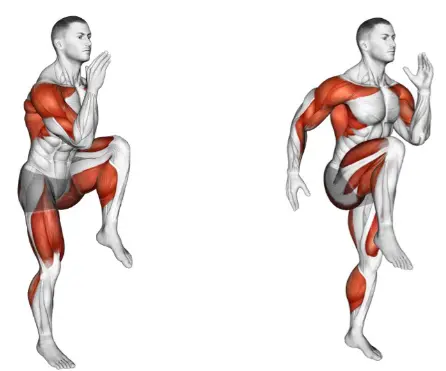
Standing Side Crunch
The Standing Side Crunch is a dynamic exercise that targets the oblique and improves core strength. Stand with feet hip-width apart, hands behind the head. Lift knee to side while bending torso, bringing elbow towards knee. Alternate sides for a complete workout.
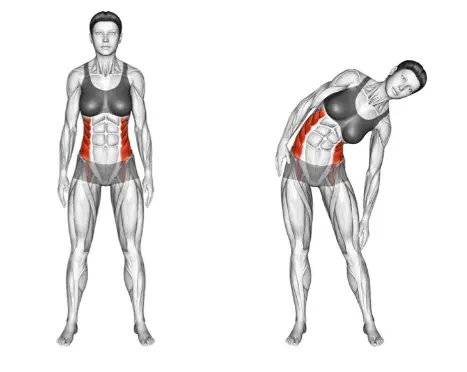
Standing Russian Twists
Standing Russian Twists engage the core and oblique muscles while standing. Hold a weight at chest height, rotate torso side to side without moving hips. This exercise improves core stability and rotational strength. Include into workouts for a dynamic and effective way to strengthen the midsection and enhance overall fitness.
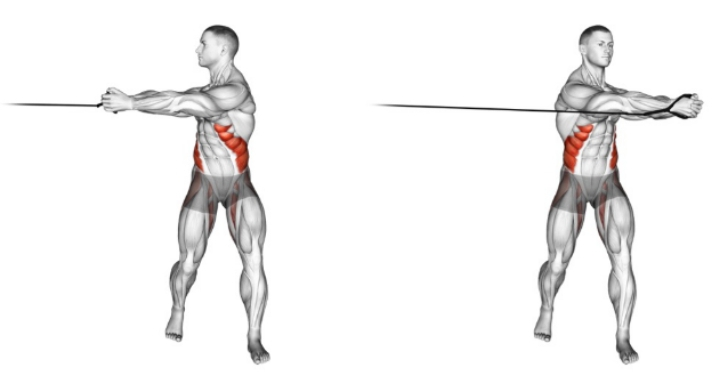
Tips for Maximizing Results
To maximize the results of your standing abs workouts, consider the following tips:
- Put Form First: Pay more attention to correct form and technique than to the quantity of reps. Ensure your movements are controlled and deliberate to effectively target the core muscles and minimize the risk of injury.
- Increase Intensity Gradually: Gradually increase the intensity of your workouts by adding resistance, increasing the duration or intensity of each exercise, or including advanced variations.
- Include Compound Movements: Integrate compound movements that engage multiple muscle groups simultaneously, such as woodchoppers or standing Russian twists. These exercises not only target the core but also recruit other stabilizing muscles for a more comprehensive workout.
- Include Cardiovascular Exercise: Combine standing abs workouts with cardiovascular exercise, such as running, cycling, or swimming, to burn calories and reduce overall body fat. A lower body fat percentage can help reveal the definition of your abdominal muscles.
- Maintain a Balanced Diet: Fuel your body with a balanced diet rich in lean proteins, healthy fats, fruits, vegetables, and whole grains. Proper nutrition supports muscle growth, recovery, and overall health, which are essential for achieving visible results.
- Stay Hydrated: Drink an adequate amount of water before, during, and after your workouts to stay hydrated and support optimal muscle function. Dehydration can impair exercise performance and recovery.
- Get Sufficient Rest: Allow your muscles time to recover and repair by including rest days into your workout routine. Aim for at least 48 hours of rest between intense standing abs workouts to prevent overtraining and reduce the risk of injury.
By implementing these tips into your standing abs workout routine, you can optimize your efforts and achieve your fitness goals more effectively. Remember to listen to your body, make adjustments as needed, and stay consistent with your exercise routine for long-term results.
Common Mistakes to Avoid
To ensure the effectiveness and safety of your standing abs workouts, it’s important to avoid common mistakes that can compromise your form and hinder your progress. Mistakes:
- Arching or Rounding the Back: Maintain a neutral spine throughout each exercise to prevent excessive strain on the lower back. Avoid arching or rounding your back, as this can lead to discomfort or injury.
- Holding Your Breath: Remember to breathe steadily throughout the movement, inhaling as you prepare and exhaling as you execute the exercise. Holding your breath can increase intra-abdominal pressure and decrease oxygen delivery to your muscles.
- Using Momentum: Avoid using momentum to power through the movements. Instead, focus on controlled, deliberate motions to fully engage your core muscles and maximize the effectiveness of each exercise.
- Neglecting Proper Alignment: Pay attention to your body alignment to ensure optimal muscle engagement and joint stability. Avoid leaning too far forward or backward, and keep your shoulders stacked over your hips.
- Overextending the Neck: Keep your neck in a neutral position by aligning it with your spine. Avoid straining your neck by pulling on it with your hands or craning it forward during exercises.
- Relying on Equipment: While equipment such as dumbbells or resistance bands can add resistance and intensity to your workouts, don’t rely solely on them. Focus on mastering bodyweight exercises first before including additional equipment.
- Ignoring Muscle Imbalances: Address any muscle imbalances by ensuring that both sides of your body are equally engaged during exercises. Pay attention to symmetry and balance to prevent overuse injuries and promote overall strength.
By avoiding these common mistakes and maintaining proper form and technique, you can optimize the effectiveness of your standing abs workouts and minimize the risk of injury. Remember to listen to your body, start slowly, and gradually increase the intensity as you build strength and confidence.
Conclusion
In conclusion, standing abs workouts offer a convenient and effective way to strengthen and tone your core muscles without the need for specialized equipment or floor exercises. By including dynamic movements that engage multiple muscle groups simultaneously, such as standing Russian twists, you can improve balance, stability, and overall core strength. Additionally, following proper form and technique, avoiding common mistakes, and staying consistent with your workouts are key factors in maximizing results and preventing injury. With dedication, patience, and a well-rounded approach to fitness, you can achieve a strong and sculpted midsection while enjoying the flexibility and accessibility of standing abs workouts.
FAQs
Q. Can standing abs workouts replace traditional floor-based ab workouts?
While standing abs workouts offer numerous benefits, they should ideally complement rather than replace traditional ab workouts. Including a variety of exercises ensures comprehensive core training.
Q. How long does it take to see results from standing abs workouts?
Results vary depending on factors such as frequency of workouts, diet, and individual fitness level. With consistent effort, you may start noticing improvements in core strength and definition within a few weeks.
Q. Are standing abs exercises suitable for beginners?
Yes, standing abs exercises are beginner-friendly and can be easily modified to suit different fitness levels. Start with simpler movements and gradually increase intensity as you build strength and confidence.
Q. Can I do standing abs exercises every day?
While it’s possible to perform standing abs exercises daily, it’s generally recommended to allow for adequate rest and recovery between workouts. Aim for 2-3 sessions per week, with at least one day of rest in between.
Q. How can I prevent muscle imbalances while doing standing abs exercises?
To prevent muscle imbalances, focus on maintaining symmetry and balance between both sides of your body during exercises. Pay attention to proper form and technique, and include unilateral exercises to address any disparities in strength or flexibility.
